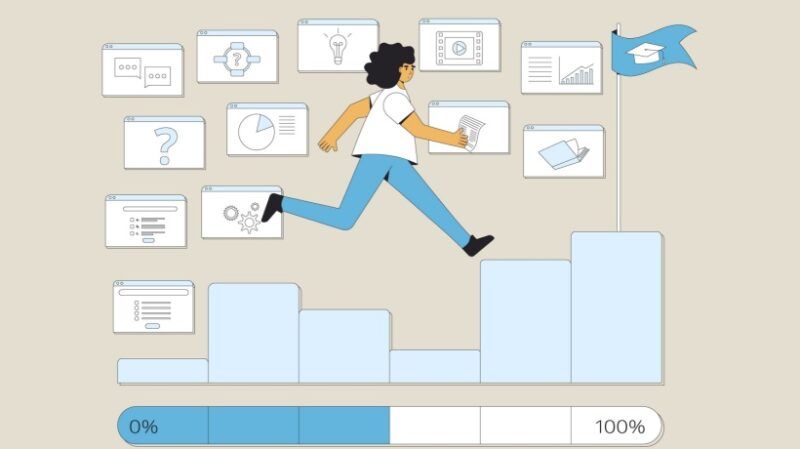

Navigating The Risks Of eLearning Gamification: What Educators Need To Know
In recent years, gamification has taken over the world of eLearning, giving educators a diverse set of tools to enhance learner engagement. Features such as leaderboards, badges, points, and challenges transform traditional eLearning courses into fun activities without diminishing their educational value. However, gamification has a dark side that eLearning instructors need to be aware of to make the most of its numerous benefits. This article explores 6 risks of eLearning gamification that educators need to overcome to foster a balanced and effective gamified learning experience.
6 Pitfalls Of eLearning Gamification
Poor Design
A potential risk to consider when developing eLearning gamification is that design plays a major role in the final learning outcomes. Unfortunately, there are various things that could go wrong in gamification design. Firstly, the experience might lean more toward the entertainment side of things than the learning, when a balance between the two is crucial. Another issue could be a mismatch between the design and the learning objectives or content. Specifically, the game elements might be too easy, oversimplifying a complex subject, or too overwhelming, distracting from the ultimate learning goal. Finally, an overly basic gamification design that looks outdated may make learners believe that the content itself is outdated, instantly decreasing their interest and engagement.
Overemphasis On Rewards
At its core, gamification aims to improve learner motivation by providing extrinsic rewards, such as points or badges. However, when learners focus excessively on climbing the leaderboard, they risk losing sight of the intrinsic value of learning. The driving force behind participating in and completing a learning course should be to advance their personal and professional development rather than simply gathering the highest number of points. If this is the case, gamification could end up undermining the learning process instead of supporting it, as it will only encourage online learners to interact with the learning content on a superficial level. Their goal will be to gain rewards, but they will not actually absorb and implement the learning content.
Increased Stress And Anxiety
This might seem like a paradox, but despite being designed to entertain learners, gamification can also cause them unnecessary stress at times. One explanation for this would be the time-based nature of most challenges presented in a gamified learning environment. Learners must have enough time to comprehend newly presented material and not feel pressured to quickly complete modules to earn a “fast learner” badge. A fast-paced and high-pressure learning environment can be counterproductive for learners, potentially causing them to feel overwhelmed, frustrated, and, at times, discouraged to continue learning. While a healthy amount of competition and motivation can be beneficial, it’s crucial to avoid creating a stressful learning environment.
Potential Inequalities
Another risk of eLearning gamification is that it can be a possible breeding ground for numerous inequalities among learners. The most obvious one would be technological accessibility. Not all networks, locations, and devices available to learners can support gamification, which can exclude those in remote locations or those who use assistive technologies. Not to mention that some gamified learning environments may require more tech-savviness than the average online user possesses. Additionally, gamification may not favor all types of learners. For example, high achievers who are already familiar with the topic at hand are more likely to perform better in a competitive setting. On the other hand, learners who require additional support will probably struggle even more.
Difficulty In Measuring Learning Outcomes
Leaderboards and scores may seem like effective ways to assess learning progress, but they don’t always paint a complete picture. Although they might be able to help you accurately measure time spent on the platform or modules completed, it is much harder to gauge equally important metrics such as knowledge apprehension, application of learning material in real-life situations, long-term retention, etc. In reality, a significant amount of prep work is required during the design phase to prevent this risk and ensure that eLearning gamification provides useful data to educators and instructors. Specifically, Instructional Designers must make sure to link game elements to learning objectives and align them with evaluation methods that produce actionable data.
Security Concerns
When learners participate in online courses, they share sensitive data that could include their email, full name, location, as well as learning progress and achievements. It is crucial for this information to be stored safely so that it’s not only protected from hackers but also from other users. Learners must have the freedom to share only the necessary amount of information with their peers to prevent discrimination or cheating. When learners are unaware of who is accessing their data, how it is stored, and how well-protected it is, concerns of consent and transparency are raised. Educators must follow ethical guidelines and transparent policies to ensure that learning is achieved without compromising their audience’s rights to privacy.
Conclusion
The importance and effectiveness of gamification in the world of eLearning cannot be questioned, as it has a proven record of increasing learner engagement and improving learning outcomes. But that doesn’t mean it doesn’t come with a few challenges. Instructors need to be aware of various aspects of gamification design and development to achieve the desired results. eLearning gamification risks such as those discussed in this article can dampen the effectiveness of your eLearning course and overshadow its educational value. Make sure to be mindful of these potential pitfalls to succeed in creating a successful gamified learning experience.